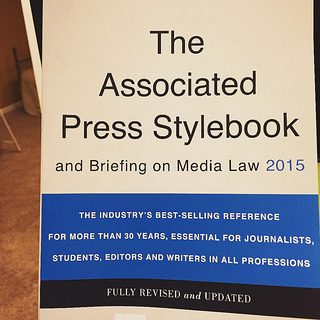
Photo credit: kartfamily
The Associated Press has just released its 2015 edition of its AP Stylebook. PR professionals should take note of the style book and its updates since it’s the style Bible for almost all media. PR pros who abide by the AP Stylebook guidelines win an advantage when submitting press releases and story pitches; those who ignore it face an additional, unnecessary hurdle.
Following AP guidelines makes sense for most all business communications. Company websites and social media accounts, for instance, would be wise to conform to the AP Style. Graphic designers should also assure that copy in graphics follow AP guidelines. Copy in marketing materials that doesn’t follow the AP guide may seem out-of-step with copy policies of established publications.
The latest AP StyleBook edition includes about 300 new or revised entries. The sports chapter underwent a substantive revamp including updates covering baseball playoffs, basketball’s NCAA Tournament, Olympic Games and other sports. For instance, Elite Eight and Final Four are now capitalized, while figure skating moves are lower case even if named after someone. Sports information directors will want to be aware of the stylistic changes.
In general, the AP seems to be trying to reduce sports jargon and clichés. “In short, avoid hackneyed words and phrases, redundancies and exaggerations,” the guidelines advise.
AP Style Updates
These are some of the other updates.
It includes entries for favorite and meme. Favorite is “A button that a Twitter user can click to express approval for a tweet, and/or to bookmark that tweet, and any associated links, for later consumption.” The word can also be used as a verb.
A meme is: “A piece of information, such as a cultural practice or idea, that’s shared verbally or transmitted widely, often in social media.”
The book includes a chapter on social guidelines but online lexicon is now in the general section.
“Animal welfare activist” is preferred rather than “animal rights activist.”
“Global warming” can be used interchangeably with “climate change.”
The book includes food updates PR pros in the food industry should know about. BLT is acceptable for bacon, lettuce and tomato. Preheat should be avoided in favor of heat.
It continues to hyphenate e-commerce and e-book, although it previously changed its style to email.
“Affordable Care Act” should be used sparingly because not all Americans know the law by its formal name. Instead, AP recommends “President Barack Obama’s health care law” or “the health care law” on first reference. Obamacare in quotation marks is acceptable on second reference.
Style Controversies
AP style revisions often prompt controversies and disagreement among etymologists. Last year, some commentators took exception to the AP’s decision that “over” can be interchangeable with “more than.” This year will probably not be an exception.
The Columbia Journalism Review says placing Obamacare into “what amount to scare quotes makes its usage seem snarky.” Initially a derogatory term, the word has entered mainstream usage – and President Obama himself says he likes it. “Fueling the flames by highlighting the controversy of the name, even unintentionally, seems ill-advised,” opines Merrill Perlman for the CJR.
The Stylebook now includes an 85-page index, helping users find words and definitions more quickly.
The guide is also available in subscription-based digital format that includes a pronunciation guide with phonetic spellings and audio pronouncers, and topical style guides about news events.
In another update, the AP is transforming AP Stylebook Mobile from a standalone app to an iOS view of AP Stylebook Online that will let users access the book through an iPhone or iPad even without an Internet connection.
Bottom Line: The AP StyleBook is the copy Bible for most all news organizations. Knowing and following the AP style guide is essential for communications professionals involved in news, sports, and social media in business and non-profit organizations.
William J. Comcowich founded and served as CEO of CyberAlert LLC, the predecessor of Glean.info. He is currently serving as Interim CEO and member of the Board of Directors. Glean.info provides customized media monitoring, media measurement and analytics solutions across all types of traditional and social media.




